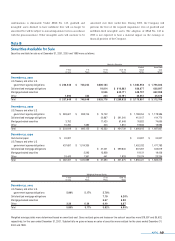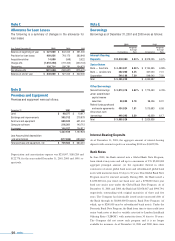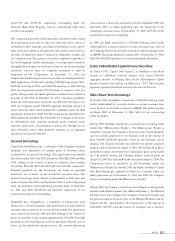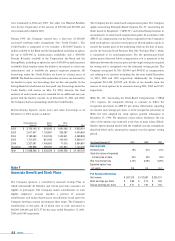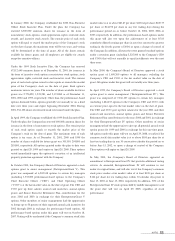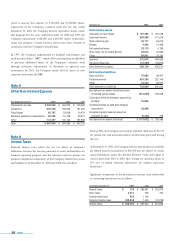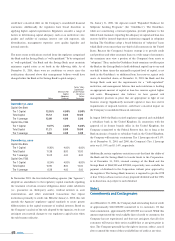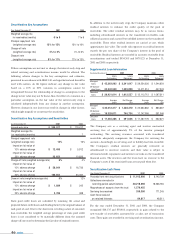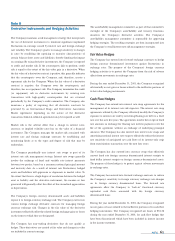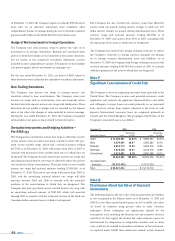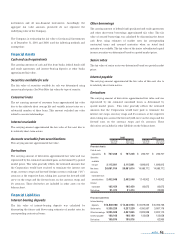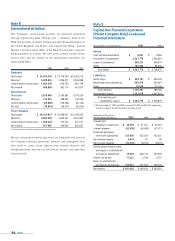Capital One 2001 Annual Report Download - page 60
Download and view the complete annual report
Please find page 60 of the 2001 Capital One annual report below. You can navigate through the pages in the report by either clicking on the pages listed below, or by using the keyword search tool below to find specific information within the annual report.
could have a material effect on the Company's consolidated financial
statements. Additionally, the regulators have broad discretion in
applying higher capital requirements. Regulators consider a range of
factors in determining capital adequacy, such as an institution's size,
quality and stability of earnings, interest rate risk exposure, risk
diversification, management expertise, asset quality, liquidity and
internal controls.
The most recent notifications received from the regulators categorized
the Bank and the Savings Bank as “well-capitalized.” To be categorized
as “well-capitalized,” the Bank and the Savings Bank must maintain
minimum capital ratios as set forth in the following table. As of
December 31, 2001, there were no conditions or events since the
notifications discussed above that management believes would have
changed either the Bank or the Savings Bank's capital category.
In November 2001, the four federal banking agencies (the “Agencies”)
adopted an amendment to the regulatory capital standards regarding
the treatment of certain recourse obligations, direct credit substitutes
(i.e., guarantees on third-party assets), residual interests in asset
securitizations, and other securitized transactions that expose
institutions primarily to credit risk. Effective January 1, 2002, this rule
amends the Agencies' regulatory capital standards to create greater
differentiation in the capital treatment of residual interests. Based on
the Company's analysis of the rule adopted by the Agencies, we do not
anticipate any material changes to our regulatory capital ratios when
the rule becomes effective.
On January 31, 2001, the Agencies issued “Expanded Guidance for
Subprime Lending Programs” (the “Guidelines”). The Guidelines,
while not constituting a formal regulation, provide guidance to the
federal bank examiners regarding the adequacy of capital and loan loss
reserves held by insured depository institutions engaged in subprime
lending. The Guidelines adopt a broad definition of “subprime” loans
which likely covers more than one-third of all consumers in the United
States. Because the Company’s business strategy is to provide credit
card products and other consumer loans to a wide range of consumers,
the examiners may view a portion of the Company’s loan assets as
“subprime.” Thus, under the Guidelines, bank examiners could require
the Bank or the Savings Bank to hold additional capital (up to one and
one-half to three times the minimally required level of capital, as set
forth in the Guidelines), or additional loan loss reserves, against such
assets. As described above, at December 31, 2001 the Bank and the
Savings Bank each met the requirements for a “well-capitalized”
institution, and management believes that each institution is holding
an appropriate amount of capital or loan loss reserves against higher
risk assets. Management also believes we have general risk
management practices in place that are appropriate in light of our
business strategy. Significantly increased capital or loan loss reserve
requirements, if imposed, however, could have a material impact on
the Company's consolidated financial statements.
In August 2000, the Bank received regulatory approval and established
a subsidiary bank in the United Kingdom. In connection with the
approval of its former branch office in the United Kingdom, the
Company committed to the Federal Reserve that, for so long as the
Bank maintains a branch or subsidiary bank in the United Kingdom,
the Company will maintain a minimum Tier 1 Leverage ratio of 3.0%.
As of December 31, 2001 and 2000, the Company's Tier 1 Leverage
ratio was 11.93% and 11.14%, respectively.
Additionally, certain regulatory restrictions exist that limit the ability of
the Bank and the Savings Bank to transfer funds to the Corporation.
As of December 31, 2001, retained earnings of the Bank and the
Savings Bank of $864,500 and $99,800, respectively, were available for
payment of dividends to the Corporation without prior approval by
the regulators. The Savings Bank, however, is required to give the OTS
at least 30 days advance notice of any proposed dividend and the OTS,
in its discretion, may object to such dividend.
Note L
Commitments and Contingencies
As of December 31, 2001, the Company had outstanding lines of credit
of approximately $142,600,000 committed to its customers. Of that
total commitment, approximately $97,400,000 was unused. While this
amount represented the total available lines of credit to customers, the
Company has not experienced, and does not anticipate, that all of its
customers will exercise their entire available line at any given point in
time. The Company generally has the right to increase, reduce, cancel,
alter or amend the terms of these available lines of credit at any time.
58 notes
To Be “ Well-
Capitalized”
Minimum For Under Prompt
Capital Corrective
Adequacy Action
Ratios Purposes Provisions
December 31, 2001
Capital One Bank
Tier 1 Capital 12.95% 4.00% 6.00%
Total Capital 15.12 8.00 10.00
Tier 1 Leverage 12.09 4.00 5.00
Capital One, F.S.B.
Tier 1 Capital 9.27% 4.00% 6.00%
Total Capital 11.21 8.00 10.00
Tier 1 Leverage 8.86 4.00 5.00
December 31, 2000
Capital One Bank
Tier 1 Capital 9.30% 4.00% 6.00%
Total Capital 11.38 8.00 10.00
Tier 1 Leverage 10.02 4.00 5.00
Capital One, F.S.B.
Tier 1 Capital 8.24% 4.00% 6.00%
Total Capital 10.90 8.00 10.00
Tier 1 Leverage 6.28 4.00 5.00



